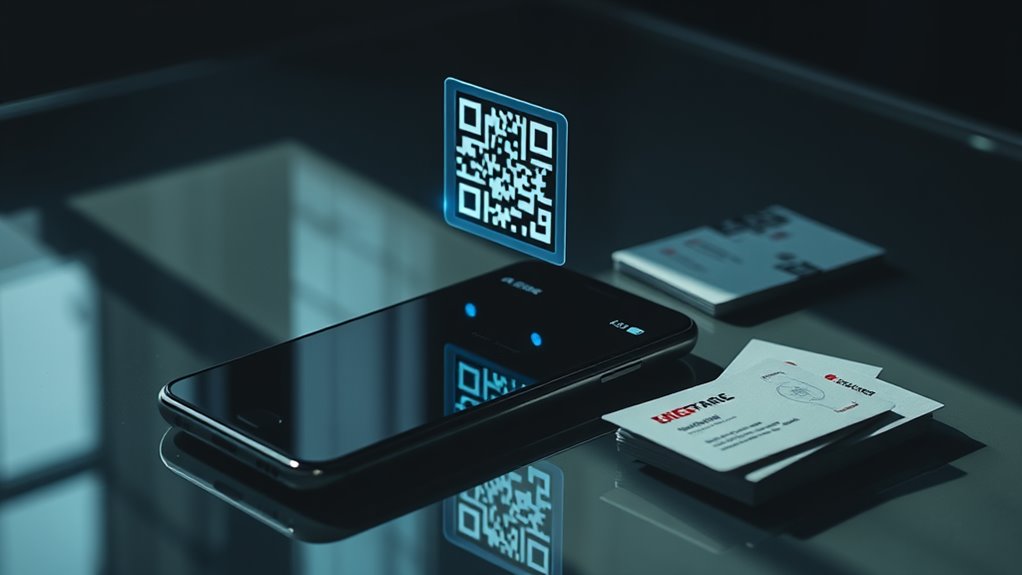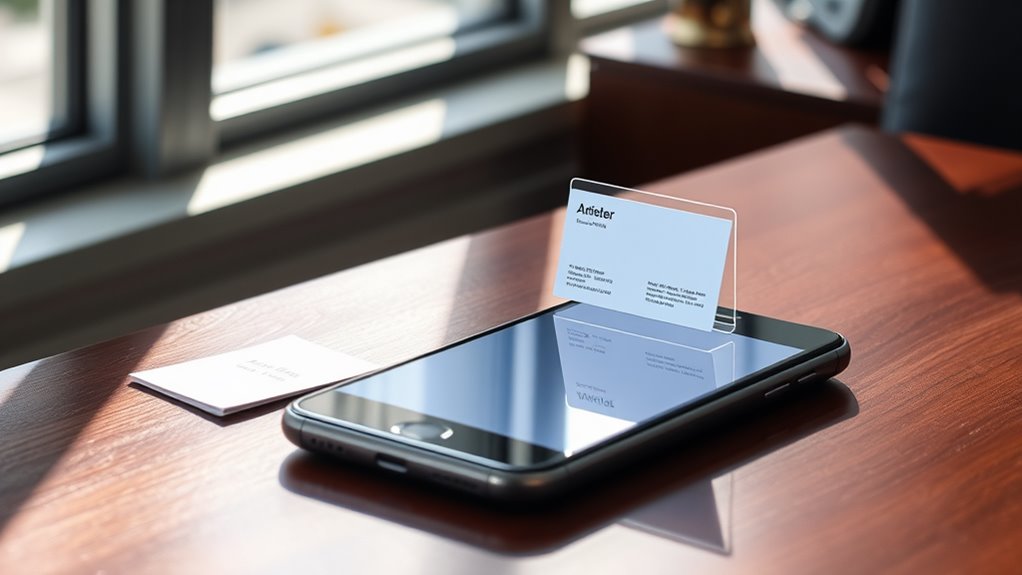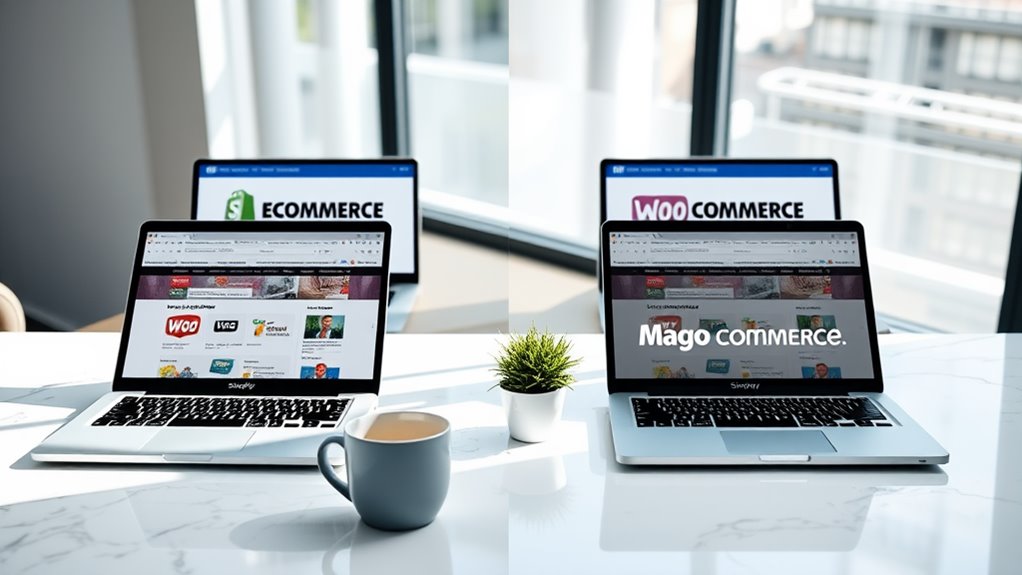Virtual business cards are definitely worth the investment, offering substantial benefits over traditional paper cards. You'll save 60-80% on costs through monthly subscriptions ($5-15) versus printed cards ($75-200 per 1,000), while gaining unlimited digital updates and enhanced tracking capabilities. They're also considerably more environmentally friendly, saving 7.2 trees per 10,000 cards and reducing carbon emissions by 6kg per 1,000 cards. With seamless CRM integration, NFC technology, and robust security features, virtual cards align perfectly with modern networking needs. The combination of cost savings, sustainability, and advanced functionality makes virtual cards an essential tool for today's professional landscape, with many more advantages to explore.
Key Takeaway
- Virtual business cards save 60-80% in costs compared to traditional cards through eliminated printing fees and unlimited digital updates.
- Digital cards provide instant analytics and CRM integration, allowing better tracking of networking success and lead management.
- Environmental impact is significantly reduced, saving 7.2 trees per 10,000 cards and reducing carbon emissions by 6kg per 1,000 cards.
- Modern sharing methods like NFC and QR codes make networking more efficient, with 70% of professionals preferring digital contact sharing.
- Enhanced security features and privacy controls protect personal information while allowing users to manage their professional visibility effectively.
The Rise of Digital Networking
The digital revolution has fundamentally changed how professionals connect and share contact information. You'll find that traditional paper business cards are rapidly giving way to virtual alternatives, with over 70% of professionals now preferring digital contact sharing methods.
Key Benefits of Digital Networking:
- Instant updates to your contact information
- Seamless integration with digital address books
- Environmental sustainability through paperless networking
- Analytics tracking for connection engagement
As you navigate modern networking environments, you'll notice that virtual business cards have become essential tools at conferences, trade shows, and remote meetings. They're particularly valuable when you're connecting with international contacts, as you can share your details across time zones without physical limitations.
Current Digital Networking Trends:
- QR code-based sharing has increased by 300% since 2020
- LinkedIn connections initiated through digital cards show 40% higher acceptance rates
- Mobile-first networking platforms have doubled in usage annually
You'll need to adapt to these changes to stay competitive in today's business landscape. Virtual networking tools aren't just convenient—they're becoming the standard for professional relationship building in an increasingly digital world.
Cost Comparison and ROI
When comparing virtual business cards to traditional paper cards, you'll find significant cost differences that impact your bottom line. Traditional cards typically cost $75-200 per 1,000 cards, while digital solutions often start at $5-15 monthly for unlimited sharing.
Cost Breakdown:
- Traditional Cards
- Printing fees: $0.07-0.20 per card
- Design costs: $50-300 one-time
- Reprint charges for updates: $75+ per batch
- Storage and organization systems
- Virtual Cards
- Monthly subscription: $5-15
- One-time setup: $0-50
- Unlimited updates at no cost
- No physical storage needed
Return on Investment:
- Measurable Analytics
- Track sharing metrics
- Monitor engagement rates
- Calculate cost per connection
You'll save approximately 60-80% annually by switching to virtual cards, considering reprinting and distribution costs. With digital solutions, you're also gaining valuable data insights that help measure networking effectiveness. Your investment becomes more strategic as you'll know exactly how many connections you're making and at what cost, allowing you to adjust your networking approach for maximum ROI.
Environmental Impact Assessment

Beyond cost savings, switching to virtual business cards delivers substantial environmental benefits that align with modern sustainability goals. When you shift to digital alternatives, you're directly contributing to reduced paper waste and decreased deforestation impact.
Environmental Impact Metrics:
- You'll save approximately 7.2 trees per 10,000 traditional business cards eliminated
- Your carbon footprint reduction equals about 6 kg of CO2 per 1,000 cards not printed
- You'll help conserve roughly 1 gallon of water for every 100 paper cards avoided
Key Sustainability Benefits:
- Zero physical waste from outdated or unused cards
- Elimination of chemical inks and coating materials
- Reduced transportation emissions from card shipping and delivery
- Decreased landfill impact from disposed cards
User Experience and Accessibility
Modern virtual business cards prioritize seamless user experiences while ensuring broad accessibility across different devices and platforms. You'll find that most digital business card solutions now offer intuitive interfaces that make sharing contact information as simple as tapping your phone or scanning a QR code. When you're networking at events or meeting clients, you won't need to fumble through your wallet anymore.
The accessibility features of virtual business cards have evolved markedly, offering:
- Screen reader compatibility that helps visually impaired users access your contact information through text-to-speech technology
- Multi-language support that automatically detects and displays content in the recipient's preferred language
- Cross-platform functionality that works seamlessly across iOS, Android, and web browsers
You'll appreciate how virtual cards adapt to different screen sizes and resolutions, ensuring your information remains crisp and legible whether viewed on a smartphone or desktop monitor. The built-in analytics also let you track when recipients view your card, helping you gauge engagement and follow up effectively. With customizable fonts, high-contrast options, and alternative text for images, you're able to create cards that everyone can access and understand easily.
Security and Data Privacy

While user accessibility remains a priority in virtual business cards, the protection of personal information demands equal attention. You'll need to take into account several key security aspects when implementing digital business cards in your professional toolkit.
Key Security Features to Look For:
- End-to-end encryption for data transmission
- Two-factor authentication options
- Secure cloud storage with regular backups
- GDPR and data privacy compliance measures
Your digital business card solution should incorporate robust privacy controls that let you manage:
- Information visibility settings
- Contact sharing permissions
- Data retention policies
- Third-party access limitations
When you're selecting a virtual business card platform, you'll want to verify that it employs industry-standard SSL certificates and maintains regular security audits. Research shows that 60% of data breaches involve personal information exposure, making it vital to choose a provider with a proven security track record.
To protect your professional information, you should:
- Regularly update your sharing preferences
- Monitor access logs for unusual activity
- Use strong passwords and unique identifiers
- Keep your virtual card platform's software current
- Review privacy policies before sharing your card
Integration With Modern Technologies
Technology platforms continue to evolve, and virtual business cards now seamlessly integrate with numerous digital tools you likely use daily. You'll find that modern digital cards work harmoniously with your existing workflow, making networking and contact management more efficient than ever.
Key Integration Capabilities:
- Your virtual business card connects directly with Customer Relationship Management (CRM) systems like Salesforce and HubSpot, allowing you to track interactions and manage leads automatically
- Through Near Field Communication (NFC) technology, you can share your card by simply tapping phones with 94% of modern smartphones supporting this feature
- Integration with calendar apps enables instant meeting scheduling when recipients receive your virtual card, reducing back-and-forth emails by up to 70%
You'll appreciate how virtual cards sync with popular productivity tools like Microsoft Teams, Slack, and LinkedIn, creating a unified professional presence across platforms. With built-in analytics capabilities, you can track when recipients view your card and which links they click, providing valuable networking insights. Additionally, your virtual card automatically updates across all platforms when you modify your information, ensuring your professional contacts always have your current details.
Real-World Implementation Success Stories

Success stories from leading companies demonstrate the transformative impact of virtual business cards across diverse industries. You'll find compelling evidence in how major corporations have successfully implemented these digital solutions.
Notable Implementation Examples:
- Tesla reduced its paper waste by 87% after switching to virtual cards in 2021, while improving lead capture rates by 34%
- Salesforce's team reported 40% faster contact exchanges using digital cards integrated with their CRM
- Microsoft's sales division documented a 28% increase in follow-up success rates with digital cards
Key Success Metrics You Can Expect:
- Immediate sharing capabilities across multiple platforms
- Enhanced tracking of card usage and engagement
- Significant reduction in printing and distribution costs
You'll appreciate how companies like IBM have leveraged virtual cards for remote hiring, resulting in 45% faster onboarding processes. Similarly, Deloitte's shift to digital cards helped them achieve their sustainability goals while improving client relationship management.
When you examine these implementations, you'll notice a common thread: organizations that embrace virtual business cards typically see ROI within three months, with average cost savings of 65% compared to traditional cards.
Conclusion
While you might be hesitating about making the switch to virtual business cards, the evidence points strongly in their favor. You'll find that the combination of cost savings, environmental benefits, and seamless technological integration makes them increasingly essential in today's digital-first world. As business continues to evolve, you can't afford to ignore this trend—your next meaningful connection might depend on having that digital card ready to share.









